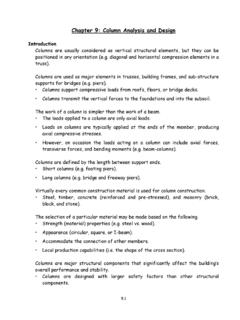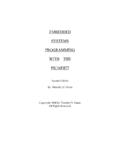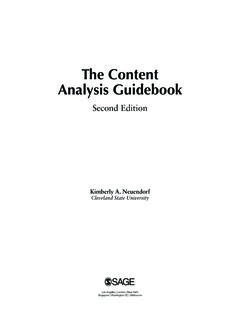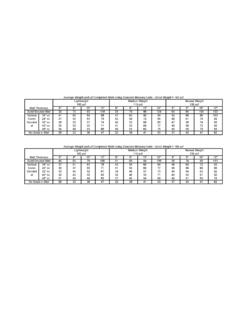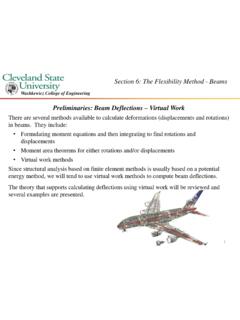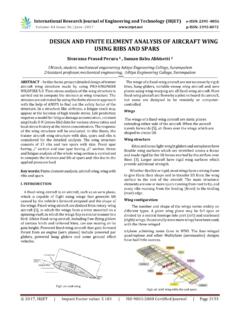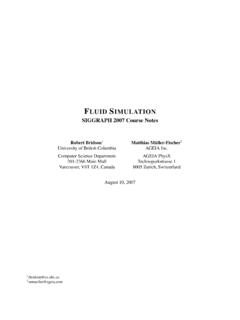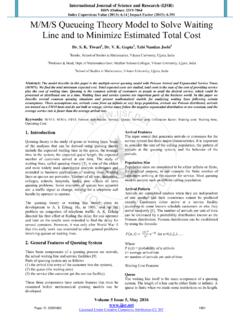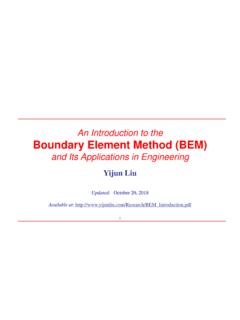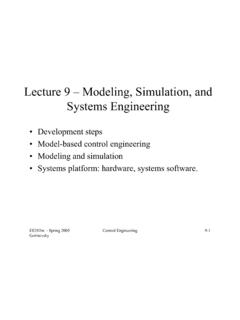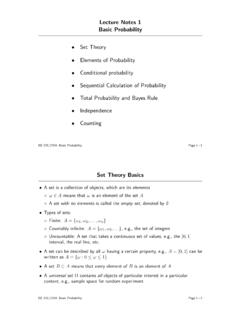Transcription of 04 Linear Viscoelasticity 1 Mechanical Models
1 21 What is Linear Viscoelasticity ? Viscoelastic materials are those for which the relationship between stress and strain depends on time. Linear viscoelastic materials are those for which there is a Linear relationship between stress and strain (at any given time). Linear Viscoelasticity is a theory describing the behaviour of such ideal materials. Strain-time curves for various constant stresses are shown in the following figure for a Linear viscoelastic material. At any given time, say 1t, the strain is proportional to stress, so that the strain due to o 3 at 1t is three times the strain due to o at the same time. Linear Viscoelasticity is a reasonable approximation to the time-dependent behaviour of polymers, and metals and ceramics at relatively low temperatures and under relatively low stress.
2 Some observed phenomena in real materials In the figure below is shown the typical response of a viscoelastic material to a creep-recovery test, that is, to a constant load and to the subsequent removal of that load. It first suffers an instantaneous strain upon loading. This may include elastic and permanent plastic strain. The strain then increases over time. This time-dependent response is known as creep. The strain usually increases with an ever decreasing strain rate. A steady state, that is one of constant strain rate, is usually reached (if the load is applied for long enough) in metals at high temperatures, but many materials whose response is Linear often do not ( many plastics, metals at low stress levels, etc.)
3 Some of the strain that accumulates during creep will be recoverable upon Linear Viscoelasticity Mechanical (rheological) Models to o 2o 31t2t 22unloading and some will not. We cannot detect the ratio of recoverable to permanent creep strain until the load is removed1. When unloaded, the elastic (instantaneous) strain is recovered immediately. More strain is then recovered over time - this is known as anelastic recovery (or "delayed elastic recovery", for obvious reasons). This anelastic strain is usually very small for metals, but may be significant in polymeric materials. A permanent strain may then be left in the material - this will include the instantaneous plastic strain and the permanent creep strain. In the next figure is shown the typical response of a viscoelastic material to a relaxation test, that is, to a constant strain.
4 1 There is some evidence that the initial, transient, creep strain is in the main recoverable, and that the later steady-state creep is permanent, though this is not true in general. t timetstrainstressinitialstresststressrel axation t timetstressstrainanelasticrecoveryinstan taneousstrainpermanent straintanelastic & permanentcreepelasticrecovery 23 E ttMechanical (rheological) Models The word viscoelastic is derived from the words "viscous" + "elastic", that is, a viscoelastic material exhibits both elastic and viscous behaviour. We can build up a theory of Linear Viscoelasticity by considering simple Linear elements such as the (elastic) Linear spring and the (viscous) Linear dash pot2.
5 We will start with simple Models and increase the complexity until we have an infinite number of elements. In general, the more elements we have, the more accurate will our model be in describing the real response of real materials. That said, the more complex the model , the more material parameters there are which need to be evaluated by experiment - the determination of a large number of material parameters might be a difficult, if not an impossible, task. We will first examine these Models with an emphasis on the physical responses of the spring and dash pot elements. Later on we will re-examine them from a more mathematical perspective, using the Laplace transform. We will only look at 1-dimensional Models . We will examine ways of extending our analysis to 3-dimensions later on.
6 We can gauge the viability of our Models by seeing whether they predict the observed responses of real Models to some simple loads/strains. In particular, do they predict the creep, recovery and relaxation stress/strain curves discussed above? The Linear Elastic Solid (the " Linear spring") The simplest way to create a model of a material is to suppose that it consists of nothing but a Linear spring of stiffness E. The constitutive equation for the Linear elastic solid is then simply E1 The creep and recovery behaviour of the material to a suddenly applied load o is as shown, Eo/ . An important point to make, even though it is obvious and self-evident, is that the spring reacts instantly to the load, and when the load is removed it again reacts instantly.
7 The response may also be written in the form Jo and J is known as the compliance (the inverse of the stiffness). 2 A non- Linear theory can be developed by including non- Linear dash pots (strain rate not linearly proportional to stress). 24 velocityfixed plateyThe response of our ideal material is obviously not very representative of the response to a real material (which is indicated by the dotted line). There is no creep stage, anelastic recovery or permanent creep strain. The Linear Viscous Fluid (the " Linear dash pot") First, consider an ideal incompressible viscous fluid (an incompressible "Newtonian" fluid) bounded by a movable upper plate and a fixed lower plate, as shown.
8 Flow of the fluid may be induced by the application of a shear stress to the upper plate. The fluid in contact with the upper plate will "stick" to it and move quickly, but the fluid at the lower fixed plate will not move. A velocity gradient is thus established and it can be shown (and verified experimentally) that the velocity gradient is related to the applied shear by a constant , the viscosity of the fluid. Thus 1 dydv Now dtudvx/)( , and shear strain is related to the displacements through dyudx/)( . Thus dtddydudtddtdudyddydvxx and it follows that the shear strain rate is proportional to the shear stress, 1 This idea of viscous fluid flow is used in the analysis of viscoelastic materials. We can imagine a bar of material acting like a fluid when under tension.
9 In that case we have normal stress and strain rates, / . Consider now a dash pot (a piston moving in a viscous fluid of viscosity ). For this dash pot we assume the above ideal fluid behaviour 1 That is, the larger the stress, the faster the material strains. The strain due to a suddenly applied load o may be obtained by integrating this expression; we have (assuming zero initial strain) to The strain is seen to increase linearly and without bound so long as the stress is applied. Note that there is no movement of the dash pot at the onset of load. It takes time for the strain to build up. When the load is removed, there is 25 tt E 1 2 no stress to move the piston back through the fluid, so that any strain built up is permanent.
10 Note that the strain is proportional to stress, as it must be for a Linear material. Again, this Linear relationship between stress and strain may be emphasised by rewriting the response in the form /)(),()(ttJtJto The compliance J is now a function of time, and is called the creep compliance function3. The creep and recovery response of the material is as shown. The slope of the creep-line is /o. There is no instantaneous strain, creep of ever-decreasing strain rate, elastic recovery or anelastic recovery, but there is a permanent strain (all the creep strain is permanent). The Maxwell model The Maxwell model consists of a spring and a dash pot in series. We can divide the total strain into two separate strains, one for the spring (1 ) and one for the dash pot (2 ).
